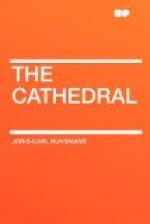“It taught the grown-up children the catechism by means of the stone sentences of the porches,” exclaimed Durtal.
“Yes, it did that too. But now,” the Abbe went on, after a pause, “before entering on the subject of architectural symbolism, we must first establish a distinct notion of what Our Lord Himself did in creating it, when, in the second chapter of the Gospel according to Saint John, He speaks of the Temple at Jerusalem, and says that if the Jews destroy it He will rebuild it in three days, expressly prefiguring by that parable His own Body. This set forth to all generations the form which the new temples were thenceforth to take after His death on the Cross.
“This sufficiently accounts for the cruciform plan of our churches. But we will study the inside of the church later; for the present we must consider the meanings of the external parts of a cathedral.
“The towers and belfries, according to the theory of Durand, Archbishop of Mende in the thirteenth century, are to be regarded as preachers and prelates, and the lofty spire is symbolical of the perfection to which their souls strive to rise. According to other interpreters of the same period, such as Saint Melito, Bishop of Sardis, and Cardinal Pietro of Capua, the towers represent the Virgin Mary, or the Church watching over the salvation of the Flock.
“It is a certain fact,” the Abbe went on, “that the position of the towers was never rigidly laid down once for all in mediaeval times; thus different interpretations are admissible according to their position in the structure. Still, perhaps the most ingeniously refined, the most exquisite idea is that which occurred to the architects of Saint Maclou at Rouen, of Notre Dame at Dijon, and of the Cathedral at Laon, for example, who built rising from the centre of the transepts—that is above the very spot where, on the Cross, the breast of Christ would lie, a lantern higher than the rest of the roof, often finishing outside in a tall and slender spire, starting as it were from the Heart of Christ to leap with one spring to the Father, to soar as if shot up from the bow of the vaulting in a sharp dart to reach the sky.
“The towers, like the buildings they overshadow, are almost always placed on a height that commands the town, and they shed around them like seed into the soil of the soul, the swarming notes of their bells, reminding all Christians by this aerial proclamation, this bead-telling of sound, of the prayers they are commanded to use and the duties they must fulfil; nay, at need, they may atone before God for man’s apathy by testifying that at least they have not forgotten Him, beseeching Him with uplifted arms and brazen tongues, taking the place as best they may of so many human prayers, more vocal perhaps than they.”
“With its ship-like character,” said Durtal, who had thoughtfully approached the window, “this Cathedral strikes me as amazingly like a motionless vessel with spires for masts and the clouds for sails, spread or furled by the wind as the weather changes; it remains the eternal image of Peter’s boat which Jesus guided through the storm.”




